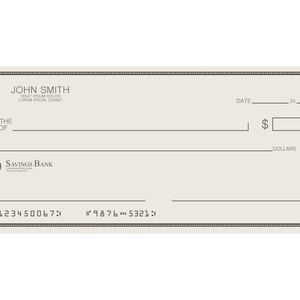
Each check you write has a string of numbers on the far left at the bottom. These numbers are needed to make sure that your checks are processed correctly and your account balances are kept up to date. You also need these numbers if you use mobile payment apps, such as Venmo and Google Pay.
This line of numbers is divided into three sets. These sets of numbers include the routing transit number, bank account number and check number. These numbers enable bank microreaders to scan this data and make a record of the transaction.
Here’s what these sets of numbers mean and why they're important.
The Routing Transit Number
The first set of numbers is the bank’s routing transit number. The American Bankers Association created this code of numbers in 1910 to eliminate confusion when identifying banks. It is used to process checks and clear funds for electronic transfers. Routing transit numbers are also needed for online banking and clearinghouses that process financial transactions.
A routing transit number is a nine-digit code that signifies at which U.S. bank your account was opened. It's the first set of numbers following the character symbol printed on the far left side at the bottom of your check.
The first four digits identify the Federal Reserve Bank district where the financial institution is located. The next four digits are a unique identifier for the specific bank where the account was opened. The last digit is a classifier for the check. The character symbols surrounding the numbers are not part of the bank’s identifying code.
Only banks that are federally or state chartered have routing transit numbers. Routing transit numbers are also known simply as a “transit number” or the “ABA number.”
Read More: What Do the Codes on Personal Checks Mean?
Your Bank Account Number
Your specific bank account number is the second set of numbers printed on the bottom of your check to the right of the bank routing number. They typically only go up to 12 digits.
If you have several accounts at a bank, such as personal and business accounts, each one has its own unique account number. If all the accounts are at the same bank, they'll have the same routing number.
You'll need to know your bank routing number and checking account number if you want to enroll in direct deposit for your paycheck or if you need to set up an electronic payment. Direct deposits let the sender put money directly into your account electronically instead of mailing you a paper check. If you're receiving funds from the Internal Revenue Service, you need to give them your bank account number and bank routing number.
Read More: Step-by-Step: How to Write a Check
The Check Number
The third set of numbers at the bottom of your check is the number of the check. You won’t need this number except to make sure it’s recorded in your check register.
Setting Up Monthly Debits
You can use your bank account number to set up monthly debits to pay bills. It's a convenient way to make sure your bills are paid on time. You can use monthly debits to automatically pay bills such as credit card bills, utility bills, car payments or a mortgage.
To set up automatic payments, you have to give the merchant permission to withdraw from your bank account on specific dates. You have to make sure to keep enough funds in your account to cover the automatic debits and not overdraw your account.
Read More: Banking Rules on Personal Checks
Setting Up a Wire Transfer
You need a routing transit number to set up a wire transfer through your bank. A wire transfer is an electronic funds payment through a worldwide network of banks. Money moves through the system with the recipient’s account information, bank account number and the amount of the payment.
Having the correct routing transit number and account number is essential to getting the funds smoothly to the correct receiving party.
Always keep your bank account number in a secure location, and don't give it out to any party you don't trust.
References
- Bankrate: Where Is the Account Number on a Check?
- Investopedia: Routing Number vs. Account Number: What's the Difference?
- Consumer Financial Protection Bureau: How Do Automatic Debit Payments From My Bank Account Work?
- Bankrate: What Is the Routing Number on a Check and How Does It Work?
- American Bankers Association. "ABA Routing Number." Accessed March 6, 2020.
Writer Bio
James Woodruff has been a management consultant to more than 1,000 small businesses. As a senior management consultant and owner, he used his technical expertise to conduct an analysis of a company's operational, financial and business management issues. James has been writing business and finance related topics for work.chron, bizfluent.com, smallbusiness.chron.com and e-commerce websites since 2007. He graduated from Georgia Tech with a Bachelor of Mechanical Engineering and received an MBA from Columbia University.

